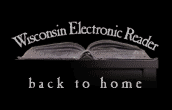
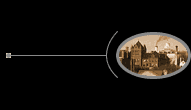

 |
  |
|
| Arrival of President Bascom. |
When Dr. Bascom arrived from Williams College, at the beginning of the spring term of 1874, to enter upon the presidency of the University of Wisconsin, there were but 407 students to welcome him.1 Nine professors (in addition to the law faculty of seven), and nine instructors, constituted the teaching force.2 North Hall (1851), South Hall (1855), University Hall (1859), the old Gymnasium (1870) and Ladies' Hall (1871) were the only buildings upon the campus; of these, Ladies' Hall alone had been erected from State money. Madison, although a city in name, could not yet boast of ten thousand inhabitants, and in many respects resembled a typical New England college town. The new president no doubt found it easy to settle down in this quiet beauty-spot, and soon adapted himself to his environment. |
 JOHN BASCOM |
| Critics converted. |
The several reports for 1874 indicate that renewed vigor had now come to the University. The board of visitors open their report with a curious admission, showing that the province of the University in the educational system of the State was still, at this late day, misunderstood by many intelligent citizens: "Entire frankness demands the confession from some of us-- not all--that we began the task to which you had invited us, with more or less misgiving and questioning as to the need of such an institution in our state; and, if such need did exist, as to whether it were finding itself met." Then, as to-day, it needed but an actual examination of existing conditions to set critics aright; the report, with admirable candor, proceeds: "Familiarity with its faculty, students, methods and work awakened an interest akin to enthusiasm, and transformed the cool criticism with which the work began, into the warm approbation with which it ended." They believe that Dr. Bascom is "the right man in the right place;" make intelligent comment on the details of University work, and close by calling on the legislature for more money for the pressing needs of the institution, particularly for a hall of science and a competent library--the condition of the latter being "a disgrace to the State." The President's report adds to these wants a "chapel, enlarged instruction, astronomical observatory." The only building available at this time for the general purposes of instruction was University Hall; for North and South Halls were then utilized entirely as dormitories for the men, and Ladies' Hall for the women. |
|
| Lewis Prize instituted. |
At the June meeting of the regents, it was voted "to give a prize of $20 each year, at such time and under such regulations as the faculty shall determine, to the undergraduate student who shall produce the best written essay; that the name of the prize shall be the instituted, 'Lewis Prize,' and that the name of the successful competitor of each year shall be published in the next issued catalogue of the University." The fund from which this prize was awarded was a donation of $200 made to the University in 1866, by ex-Governor James T. Lewis, but as this sum was not sufficient to accomplish the object of the donor, it was placed at interest until June 17, 1873, when it had amounted to $300. With the money, the treasurer was directed to purchase three United States six per cent bonds of $100 each, the income of which was, beginning with 1875, devoted to the payment of this prize for "the best commencement piece."3 After 1888, the income of the fund was ordered paid to that student "who shall be given first place at the final contest of the University Oratorical Association." |
 STEPHEN H. CARPENTER |
| Old Science Hall built. |
Aroused by the appeal of the regents and the board of visitors, made in the autumn of 1874, the legislature again came forward with the donation of a second State building for the University. By chapter 61, laws of 1875, the sum of $80,000 was appropriated "to build an additional edifice for scientific purposes upon the University grounds." This building, known to University history as "Old Science Hall" was completed and occupied in the spring of 1877, and destroyed by fire upon the first of December, 1884.4 |
 SCIENCE HALL
SCIENCE HALL |
| Medical College discussed. |
The legislature of 1875 also transferred to the regents the custody of the Soldiers' Orphans' Home, about two miles east of the University, upon the shore of Lake Monona, and authorized them to establish thereon a medical college. The regents entered into possession of the property, and consulted with the State Medical Society relative to the project; but the organization of such a college was thought to be "impracticable at the present time."5 In their report for the year, the regents ask legislative consent to dispose of the Orphans' Home property, and turn the proceeds into needed buildings on the campus, "with the understanding that a medical college will be organized in connection with the University, as soon as circumstances, not within the control of the board, will warrant the undertaking." Permission to sell this property was given by the legislature in February, 1876, and accordingly it was disposed of "at a reasonable price" to a Norwegian Lutheran school. The regents, however, have not yet seen their way to the establishment of a college of medicine, although a helpful pre-medical course has been given at the University since 1888. |
|
| More money needed. |
In their report for 1875 (written by President George H. Paul), the regents, while profoundly grateful for the gifts of Science Hall and the Soldiers' Orphans' Home property, are forced to call attention to the fact that "Much remains to be done by the legislative department, however, to perfect and sustain the plan of university instruction provided for by our constitution and laws." The annual income of the University now amounts, they say only to about $32,000, while the necessary current expenses for the past year were nearly $60,000. "Should all the lands now remaining on hand be sold hereafter at the most favorable prices permitted by law, the total average annual income from both funds [University lands and Agricultural College lands] would not be likely to exceed about the sum of $36,000." The amount received from the funds, they state, is wholly consumed in "the moderate salaries paid the instructional force," while "for the balance of the money necessary to meet current obligations, the board is dependent upon incidental charges to students, upon the limited products of the University Farm, and upon legislative bounty." The question of future resources is now pressing upon the board--especially in view of the prospective cost of equipping and maintaining Science Hall, of increased attendance upon the higher departments, and of the expiration (in 1876) of the special tax for ten years, levied by the legislature of 1867. "Good policy, as well as actual necessity, requires legislative action at the present time with reference to the approaching exigencies; and it is hoped that this action will be so definite and positive as to remove all doubt and embarrassment from the future." |
|
| Percentage tax levy, 1876. |
Again did the legislature, now alive to the importance of the University as a factor in public education, come to the rescue. By chapter 117, laws of 1876, there was appropriated to the University fund income, in lieu of former levies,6 an annual tax of one-tenth of a mill on each dollar of the assessed valuation of the taxable property of the State. This was made a percentage tax instead of a specified appropriation, because it was thought that as the assessed valuation rose, with the growth of wealth in the State, the University would be enabled to expand in the same degree; for its necessities were bound to increase in even a greater ratio, as the years went on. The first levy under the act (in 1877) brought the University $42,359.62; the same tax to-day, under an unusually low valuation, produces just $60,000. |
|
| Wanted: an observatory. |
The regents were, at this time, making strenuous efforts to induce some philanthropist to tender the University an astronomical observatory. To aid them in this work, the new tax-law provided that $3,000 annually, of the amount raised under this levy, be set apart "for astronomical work and for instructions in astronomy * * * so soon as a complete and well-equipped observatory shall be given the university in its own grounds without cost to the State"--provided that such observatory shall be completed within three years from the passage of the act. |
|
| Lapham cabinet purchased. |
By another act (chapter 400) of 1876, provision was made for the purchase for the University, at a cost of $10,000, of the important library and cabinet of the late Dr. Increase A. Lapham, of Milwaukee, one of the earliest, most devoted, and self-sacrificing scientists Wisconsin has ever known. Unfortunately, this collection was destroyed in the burning of Science Hall, eight years later. |
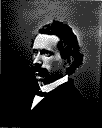 JOHN B. FEULING |
| J. A. Johnson scholarships. |
In a letter to the board, dated February 12, 1876, John A. Johnson, a wealthy Madison manufacturer, donated to the University $5,000, as a perpetual fund, the annual income of which was to be "applied in aid of attendants at the University, who have previously attended a common school or the University, at least one year * * * until the year 1900, the aid thus provided for is limited to those students [without distinction of sex] of the class already described, who can read or speak, reasonably well, one of the Scandinavian languages. * * * No student shall receive more than fifty dollars in one year, nor shall more than two hundred dollars in the aggregate be given to any one student." The ten Johnson scholarships, of $35 each, were the first upon the rolls of the University. |
|
| Magnetic Observatory. |
In their annual report for 1876, the regents state that they have, within the year, established a system by which water is pumped from Science Hall to Ladies' Hall, and fire hydrants have been furnished at all the buildings; Science Hall and Ladies' Hall have been provided with sewers connected with Lake Mendota. Gas-light has also been introduced in Ladies' Hall. The United States Coast Survey is building a magnetic observatory7 upon the grounds, upon the slope descending southward from University Hall to University avenue. "The specific object sought to be accomplished is a continuous and reliable record of the variations in the directions and intensity of the earth's magnetic force by means of photographic self-registration." This mysterious subterraneous chamber--which the students of those days were wont irreverently to call "Davies's root-cellar," because under that professor's supervision--was maintained by the Coast Survey for several years; it then fell into a state of decay, but has of late been rehabilitated by the Agricultural College as a chamber for experiments in the curing of cheese. |
 THE OBSERVATORY'S GEODETIC INSTRUMENTS |
| A senatorial investigation. |
An important event of the year was the visit of a special senate committee, appointed to examine the financial management of the University and its farm, "with a view of reducing the expenses without diminishing the benefits." The committee made a careful examination of the grounds, the buildings, and the books of account and found nothing wrong; the books, particularly, they declare to be "a clear, conspicuous, detail statement of all transactions." Their general conclusions were:8
One of the most important events of 1877 was, of course, the opening of Science Hall. Another, the report of the board of visitors,--alluded to in a previous chapter,--expressing the fear that coeducation was injuring the health of the young women, and President Bascom's crushing, but courteous, reply thereto. "Study is more congenial to the habits of young women," he contended, in conclusion, "and the visiting committee are certainly mistaken in supposing that they have to work harder in accomplishing their tasks. The reverse is true." |
|
| Washburn Observatory built. |
The regents' annual report for 1877 conveyed interesting and agreeable news--"the proposal of ex-Governor Cadwallader C. Washburn to erect upon the grounds of the University during the coming year, for the benefit of the University, an Astronomical Observatory, equipped with superior facilities for investigations in astronomical science, such observatory to be constructed and furnished wholly at the personal cost of the donor. This act is one which reflects special honor upon its author and upon our state, and goes farther to establish our claim to honorable rank as a progressive and enlightened people than any degree of material prosperity." Washburn Observatory--a tasteful stone building--was completed in 1878, upon the hill just west of what was then the president's house. The regents caused a marble tablet to be placed over the door to the rotunda, with this commemorative inscription: "Erected and finished, A. D. 1878, by the munificence of Cadwallader C. Washburn, and by him presented to the University of Wisconsin--a tribute to general science. In recognition of this gift, this tablet is inserted by the regents of the University." By chapter 65, Laws of 1879, the legislature made ex-Governor Washburn an honorary member of the board of regents "for and during his good pleasure"--a position held by him until his death in May, 1882. In accordance with the provision in the tax-levy act of 1876, of $3,000 for astronomical instruction, the chair of astronomy was created by the regents at their meeting of January 21, 1879; and Dr. James C. Watson, of Michigan, one of the most distinguished of American astronomers, was chosen to fill it, he being at the same time appointed the first director of the observatory.9 The building was, in the following year, considerably enlarged by the founder. |
 WASHBURN OBSERVATORY |
| Building of Assembly Hall and Library. |
In his report for 1877, President Bascom said: "Our one great want is an Assembly Hall and Library. These can be united to advantage in one building, and when secured in good form, will advance the University on its literary side as much as Science Hall has already advanced it; scientifically. * * * We are impatient for these most needful things, and would gladly accept the economy in other directions which is necessary for their early attainment." The regents, too, have "for some years seen the absolute necessity for an Assembly Hall upon the University grounds, capable of accommodating all the students, when at specified times, or whenever necessary, the President of the University can meet his entire charge face to face, and for lectures or society exercises." 10 Accordingly, in the spring of 1878, after "economizing and husbanding their resources for the last two years," and without asking for a legislative appropriation, the regents let the contract for such a building, to cost $35,000, and to be opened the first of October of the following year. |
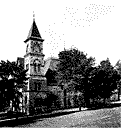 LIBRARY HALL |
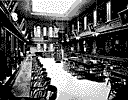 READING ROOM, U. W. LIBRARY |
||
| Improvement in faculty. |
The president's report for 1879 speaks of an "improvement of the instructional force. * * * The instructional force, in its variety, vigor and efficiency, represents, and must always represent, the value and power of the University." This increase in the staff enabled the University to now offer a much wider range of studies than heretofore; also an increase in the number of electives in the junior and senior years, and provision for more extended work in many branches. |
|
| Preparatory Department abolished. |
In 1880, the president was able to report that the preparatory department, which had been opened by Professor Sterling in February, 1849, as the nucleus of the University, was "brought to a close with the exception of the Greek Class"--retaining instruction in this department single study "simply because the general educational sentiment of the State is not yet strong enough to take it up" in the high schools. It will be remembered that the existence of this department had long been deprecated by the regents. It was continued, year by year, only until the high schools of the State should reach a position in numbers and quality that might enable them to fit students for the University. The president says that this step was finally taken because urged by the high schools, and "not without some solicitude." Many of these schools, he says, are still weak, and some portions of the State have none; they are best fitted to "meet the wants of comparatively young scholars who live at home. They do not, therefore, meet well the necessities of the young man, who, lacking early instruction and somewhat advanced in years, resolves to secure an education. He cannot without some loss of self-respect and much loss of time reduce his pace to that of the young men and women whom the University would especially wish to help, find great difficulty in making their way into it." Dr. Bascom informs the board, however, that he looks with hope upon the future, and thinks "The multiplication and improvement of High Schools must be our great resource."11 |
1 In the academic department, 169; normal, 122; preparatory, 68; commercial, 25; law, 23.
2 John W. Sterling, vice president, and professor of mathematics and astronomy; William F. Allen, professor of Latin and history; Stephen H. Carpenter, professor of logic and English literature; Alexander Kerr, professor of the Greek language and principal of Preparatory Department; John B. Feuling, professor of modern languages and comparative philology; William J. L. Nicodemus, professor of military science and civil engineering; John B. Parkinson, professor of civil polity and international law; John E. Davies, professor of natural history and chemistry; William W. Daniells, professor of agriculture and analytical chemistry; Roland D. Irving, professor of geology, mining, and metallurgy, and curator of cabinet; R. B. Anderson, instructor in languages; Robert H. Brown, instructor in English; James W. Bashford, instructor in Greek and English; Mrs. D. E. Carson, preceptress of Ladies' Hall; Miss Josephine Magoon, assistant preceptress; Miss Lizzie S. Spencer, teacher of English; Miss Augusta Buttner, teacher of French and German; Miss Sue R. Earnest, teacher of instrumental music; and Miss Mary C. Woodworth, teacher of vocal music. P. L. Spooner was dean of the law faculty, and the law professors were Supreme Justices Dixon, Cole, and Lyon, and Harlow S. Orton, J. H. Carpenter, and William F. Vilas.
3 The winners of the Lewis Prize, at commencement, were: 1875, Fannie West; 1876, Albert Samuel Ritchie; 1877, Charles Lowell Dudley; 1878, Frederick King Conover; 1879, Belle Case; 1880, Henry Decker Goodwin; 1881, Howard Leslie Smith; 1882, David Ferguson Simpson; 1883, Alice Jane Sanborn; 1884, Frederick Jackson Turner; 1885, Elizabeth Agnes Waters; 1886, William Elmer Bainbridge; 1887, Harry Elmer Briggs; 1888, Alice Esther Holt.
4 The actual cost was $79,386.53, including the incidentals of advertising and architects' fees. It is small wonder that it proved to be as inflammable as a tinder-box.
5 In his annual report, President Bascom thus presents the case: "The time does not seem to have arrived for the establishment of a medical department. The profession of the State are not agreed as to the desirability of a medical college in its bounds, and comparatively few earnestly support such an institution. Such a college, if established, should certainly be located at Milwaukee, as affording, by its size, far more clinical advantages than Madison, or than any other place within the State. We should be glad to unite a medical college in Milwaukee to the University, and should hope both to aid it, and to receive aid from it. As such an arrangement is entirely in the future, we trust that the coming legislature will allow us to sell the Orphans' Home, and to devote the proceeds to an Assembly Hall."
6 These former levies aggregated $17,303.76, so that the new tax only augmented the income by about $20,000. The regents, in their annual report (dated September 30, 1858), say of this action: "The compensation thus accorded by law for deficiencies arising from the disposition of the lands donated to the State by Congress in trust for the University, is not deemed to be in excess of the necessities of the University, or of the just and equitable obligations of the State. Nevertheless, the Regents have not hesitated to accept the conclusions of the State gratefully, as a final and satisfactory adjustment of the principal questions relating to such trust, hitherto in controversy."
7 In his report for 1877, President Bascom calls it a scientific curiosity." There was, at the same time, another magnetic observatory in Washington; and a third, maintained by the British government, at Toronto.
8 Senate Journal, 1876, p. 487.
9The directors of Washburn Observatory have been: James C. Watson, 1878-80; Edward S. Holden, 1881-85; Asaph Hall (of U. S. Naval Observatory), consulting director, 1887-93; George Cary Comstock, associate director, 1887-89-- director, after 1893. Dr. Watson died in office, early in the winter of 1880-81.
10Report for 1878.
11In his report for 1875
he had said: "We shall be glad to yield
the entire field, a portion of which we now occupy with our Sub-Freshman
classes, to the high schools, as soon as the interests of the
University will allow us to do so. * * * Just at present, for
the University to reject altogether preparatory students, would
be to endanger a portion of its labors."